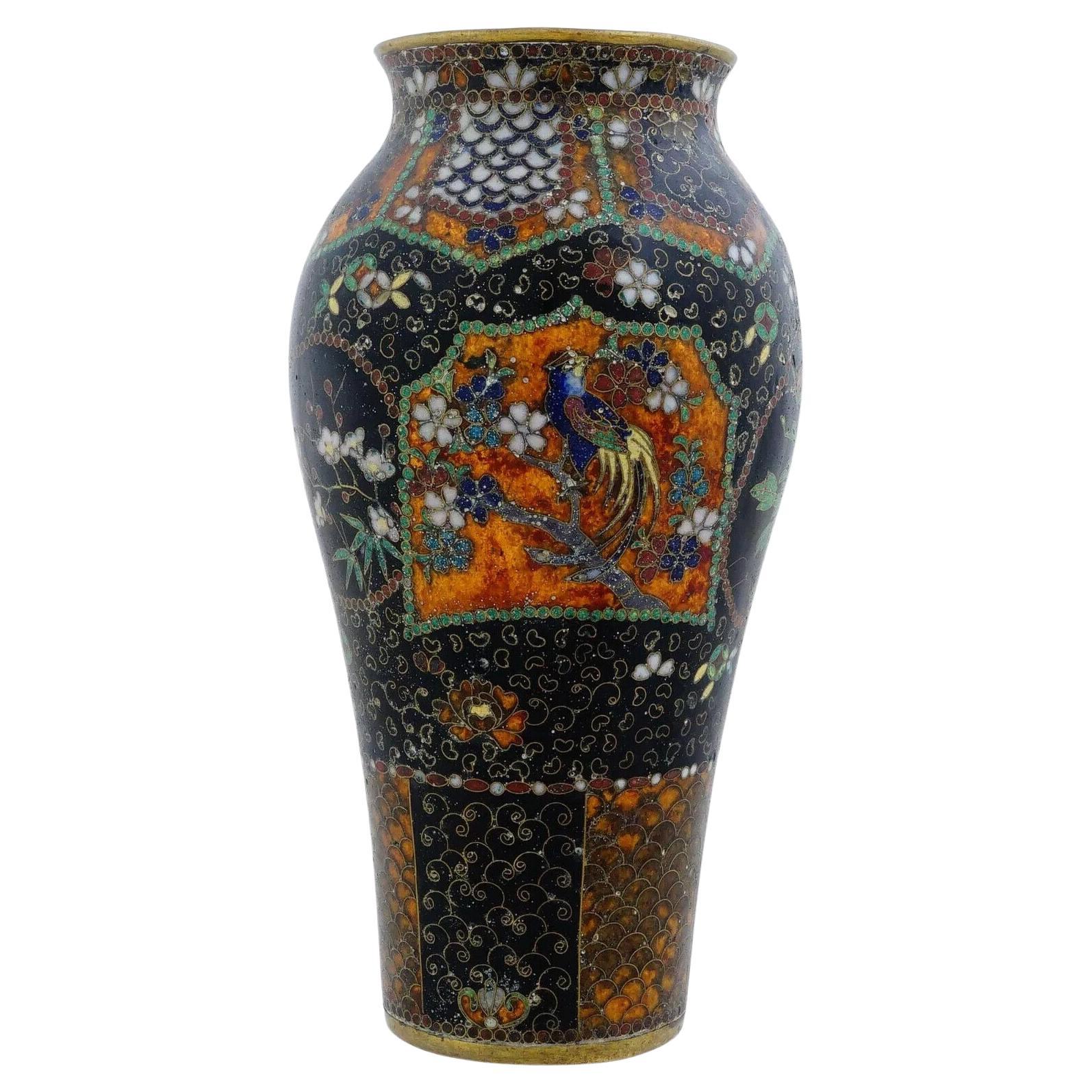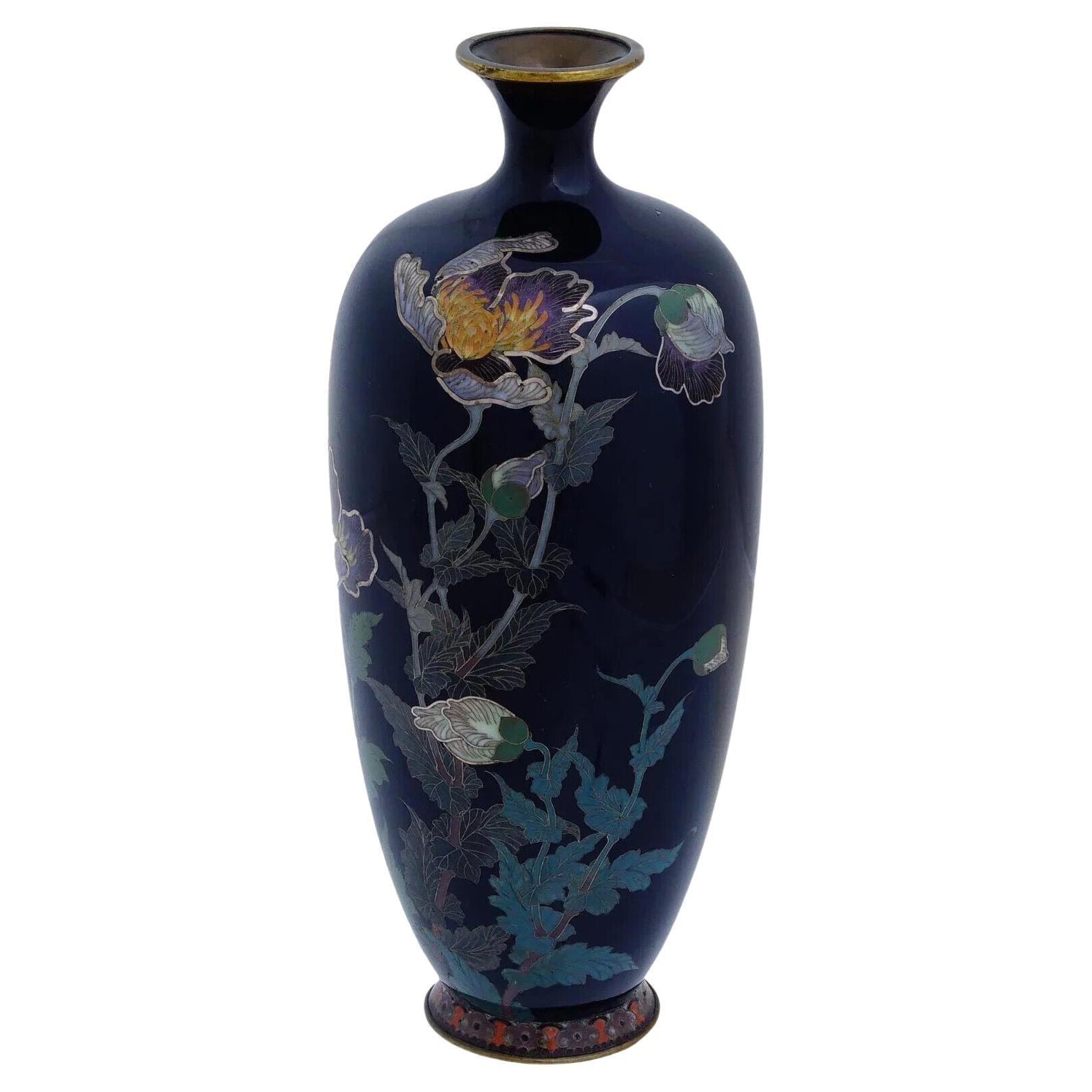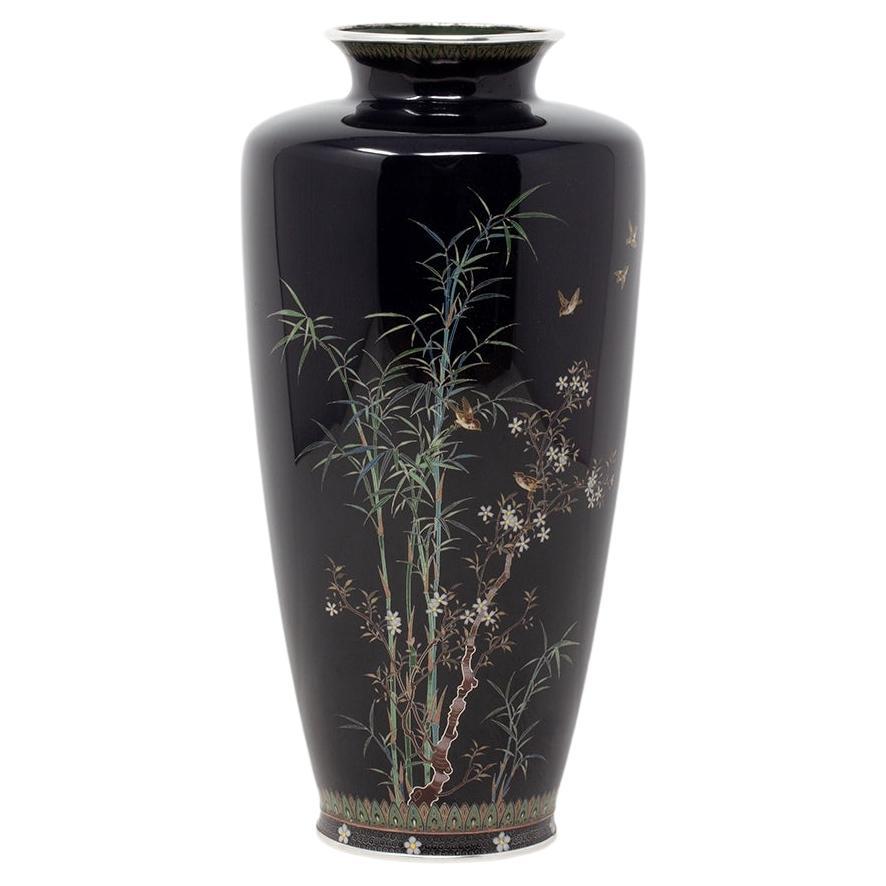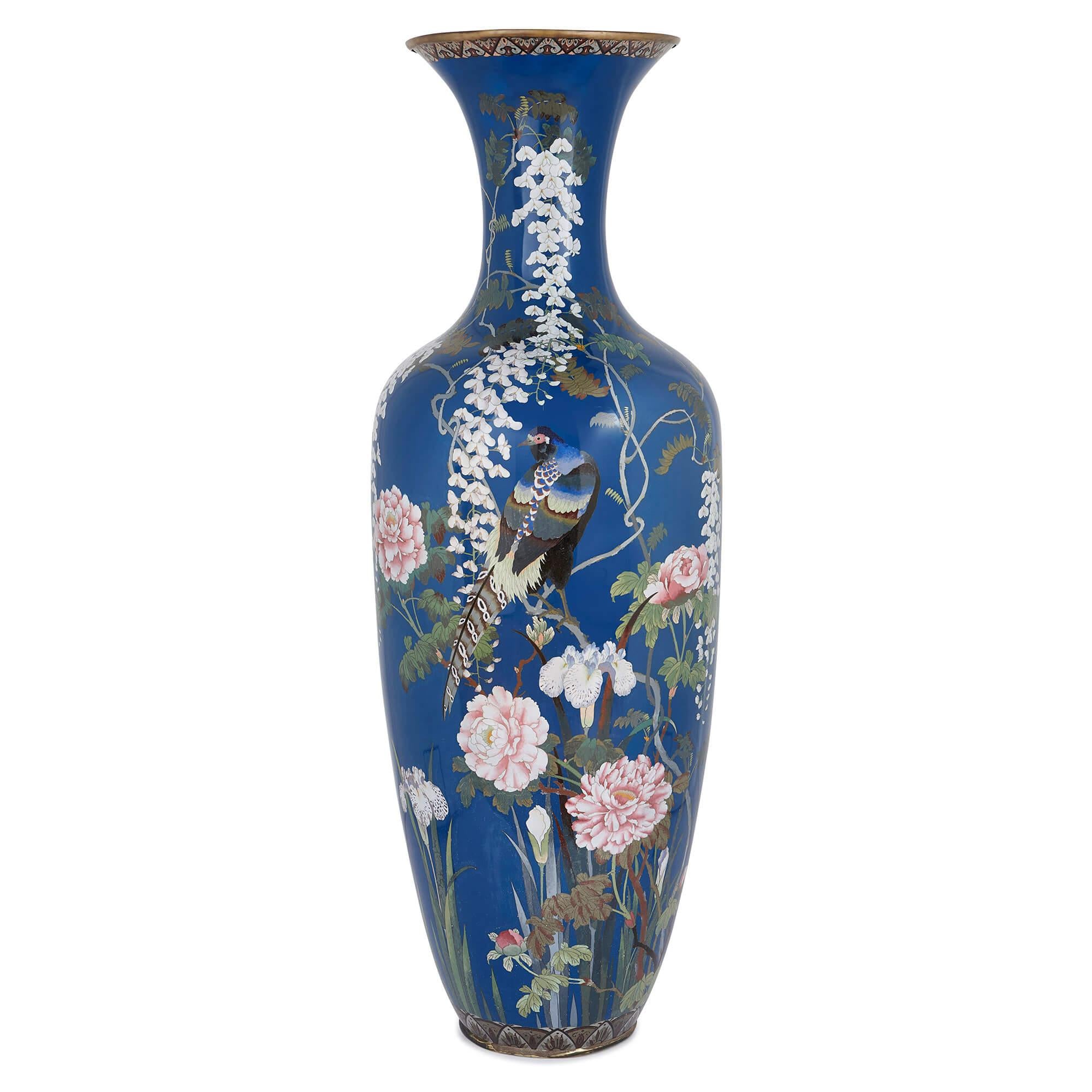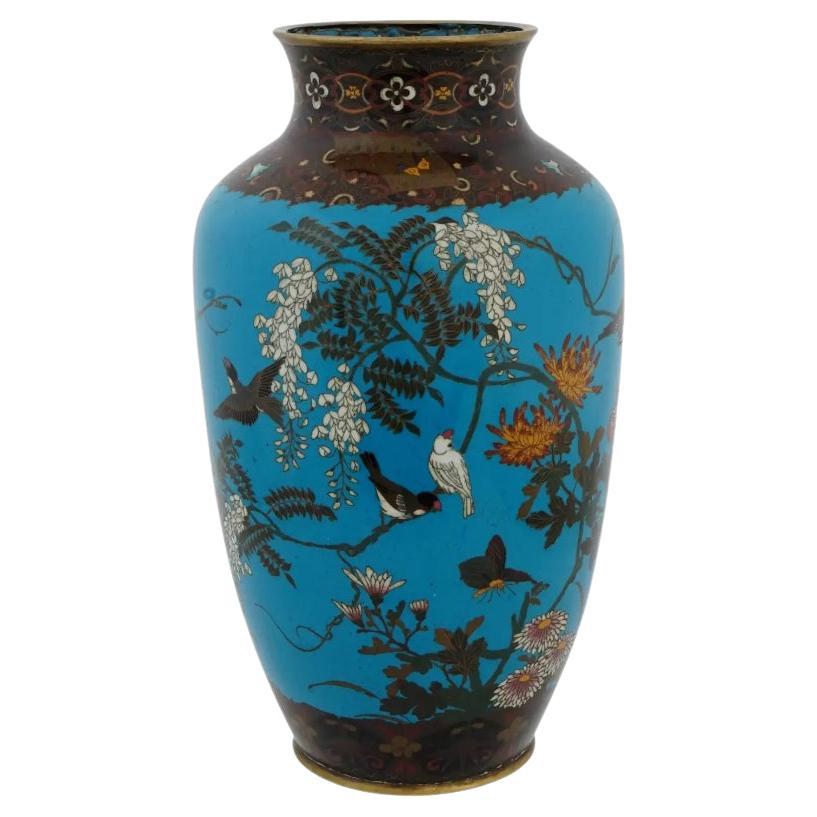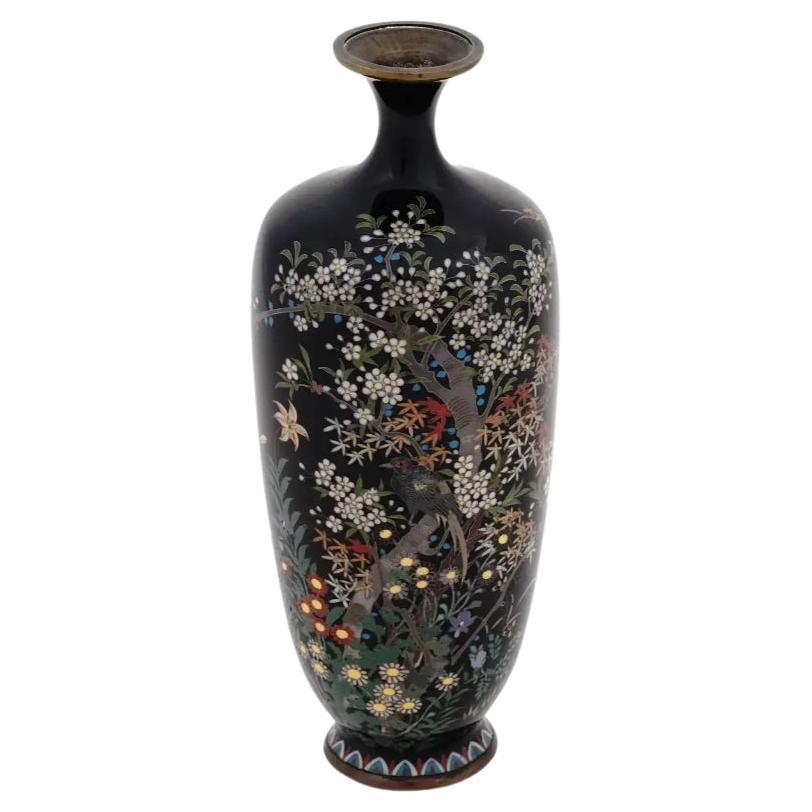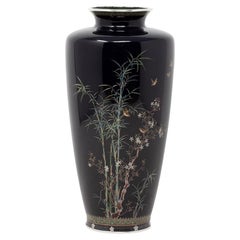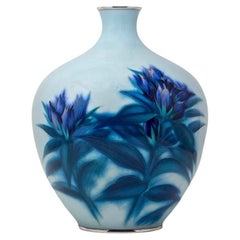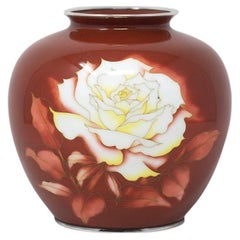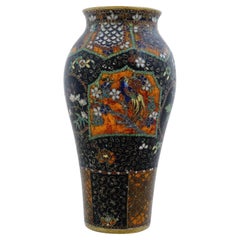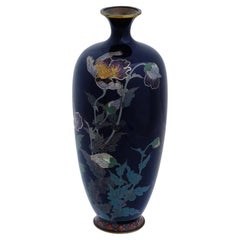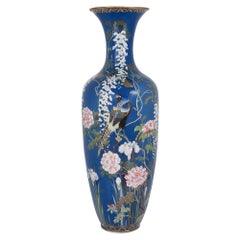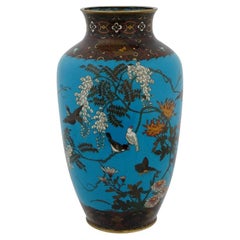Articles similaires à Vase japonais en émail cloisonné de la période Meiji par Ando Jubei
Vous voulez plus d'images ou de vidéos ?
Demander au vendeur plus d'images ou de vidéos
1 sur 19
Vase japonais en émail cloisonné de la période Meiji par Ando Jubei
3 308,54 €
À propos de cet article
Expédition internationale gratuite
Marque de la société Ando Cloisonne
De notre collection japonaise, nous avons le plaisir de vous présenter ce vase japonais en émail cloisonné par Ando Jubei. Le vase en émail cloisonné est de petite forme carrée et effilée, avec un col cintré et des épaules arrondies, le tout reposant sur un pied circulaire. L'émail cloisonné se compose d'un fond bleu foncé avec des bordures de pampilles de cigale sur les bords supérieur et inférieur. Le corps du vase est magnifiquement incrusté de fils d'argent de différents calibres avec une scène centrale représentant de grandes fleurs de cerisier au-dessus de deux coqs debout sur des écrans de bambou avec Hanashobu (fleurs d'iris), Kosumosu (fleurs de cosmos) et une rivière qui s'écoule. Le vase est monté en argent sur le dessus et le dessous et porte la marque Ando Cloisonne Company au centre de la base. Le vase japonais en émail cloisonné date de la fin de la période Meiji (1868-1912) et du début du XXe siècle, vers 1900.
Ando Jubei (1876-1956) était un artiste japonais de cloisonnement renommé, originaire de Nagoya, préfecture d'Aichi, au Japon. Jubei était considéré comme le créateur le plus prolifique de l'époque Meiji en matière de cloisonnés de présentation, dont certains étaient commandés par des membres de la famille impériale pour être offerts à des dignitaires étrangers. Jubei et un autre artiste nommé Hayashi Kodenji ont dominé l'industrie de l'émail de Nagoya à la fin de l'ère Meiji. Jubei, Namikawa Yasuyuki et Namikawa Sosuke sont considérés comme les trois artistes dont les innovations techniques ont donné naissance à "l'âge d'or du cloisonné japonais" à la fin du XIXe siècle. Jubei et son beau-frère Ando Juzaemon ont ensuite formé la société de cloisonnés Ando à la fin du XIXe siècle, sous la direction de l'artiste de cloisonnés Kawade Shibataro (1856-1921).
Ando Cloisonné Company (安藤七宝店) est une entreprise japonaise de fabrication de cloisonnés située à Sakae, Nagoya, dans le centre du Japon. Fondée à la fin du XIXe siècle par Ando Jubei (Jusaburo 1876-1953) et son beau-frère Andō Juzaemon, l'entreprise de cloisonnés a connu un grand succès. Ils ont recruté Kawade Shibataro (1856-1921), artiste cloisonneur de renom, pour diriger le studio de la société Ando, qui a développé la technique de la plique-à-jour. Au cours des 30 années du XXe siècle, la société Ando a employé plus de 50 artistes de la cloison et l'entreprise a reçu un mandat impérial de nomination auprès de la cour japonaise.
Le cloisonné est une technique qui consiste à décorer des objets en métal avec des matières colorées séparées par des fils souvent en métaux précieux. Dans un premier temps, la décoration est formée par la création d'un pochoir sur l'objet métallique en apposant des fils sur la surface qui sera visible une fois le produit terminé. L'artisan peut ainsi créer de belles scènes telles que des fleurs épanouies ou des animaux mythiques en remplissant les espaces avec différentes couleurs.
L'émail (émail vitreux), également connu sous le nom d'émail porcelaine, est un matériau obtenu par fusion de verre en poudre sur un substrat par cuisson, généralement entre 750 et 850 C. La poudre fond, s'écoule, puis durcit pour former un revêtement vitreux lisse et durable. Le mot vitreux vient du latin vitreous, qui signifie "vitreux".
L'ère Meiji est une période de l'histoire japonaise qui s'est étendue de 1868 à 1912. C'était la première moitié de l'Empire du Japon, lorsque le peuple japonais a commencé à construire le paradigme d'un État-nation moderne et industrialisé et d'une grande puissance émergente, influencée par les pays et l'esthétique occidentaux. Ces idées radicalement différentes ont entraîné de profonds changements au Japon et ont eu des répercussions sur la structure sociale, la politique, l'économie, l'armée et les relations extérieures dans tous les domaines. Cette période correspond au règne de l'empereur Meiji et a été précédée par l'ère Keio à laquelle a succédé l'ère Taisho.
Pendant la période Meiji, l'art culturel a suscité un intérêt particulier de la part du gouvernement, qui a réorganisé le marché de l'exportation de l'art, ce qui a permis de promouvoir les arts japonais par le biais de diverses expositions mondiales, à commencer par celle de Vienne en 1873. Le gouvernement finançait largement les foires et jouait un rôle actif dans l'organisation de la présentation de la culture japonaise au monde, notamment en créant une société semi-publique appelée Kiritsu Kosho Kaisha (First Industrial Manufacturing Company). La Kiritsu Kosho Kaisha a été utilisée pour promouvoir et commercialiser les exportations d'art japonais et a créé le Hakurankai Jimukyoku (Bureau des expositions) pour maintenir des normes de qualité. Pour l'exposition internationale du centenaire de 1876 à Philadelphie, le gouvernement japonais a créé un bureau du centenaire et envoyé un émissaire spécial chargé de trouver un espace pour les 30 000 objets qui seraient exposés. La maison impériale s'est également intéressée de près à l'art et à l'artisanat, commandant des œuvres à des artistes triés sur le volet pour les offrir aux dignitaires étrangers, soulignant ainsi la grande qualité et l'importance de l'art japonais. Juste avant la fin du XIXe siècle, en 1890, le système Teishitsu Gigeiin (artiste de la maison impériale) a été créé pour reconnaître les artistes distingués. Ces artistes ont été sélectionnés pour la qualité exceptionnelle de leurs produits et leur talent dans leur secteur d'activité. Pendant 54 ans, soixante-dix artistes ont été nommés, parmi lesquels le céramiste Makuzu Kozan et l'artiste de l'émail cloisonné Namikawa Yasuyuki.
- Créateur:
- Dimensions:Hauteur : 12 cm (4,73 po)Largeur : 6 cm (2,37 po)Profondeur : 5 cm (1,97 po)
- Style:Meiji (De la période)
- Matériaux et techniques:
- Lieu d'origine:
- Période:1900-1909
- Date de fabrication:Circa 1900
- État:Usure conforme à l'âge et à l'utilisation.
- Adresse du vendeur:Newark, GB
- Numéro de référence:Vendeur : SPRD1stDibs : LU6971241421432
À propos du vendeur
5,0
Vendeur Or
Vendeurs premium dont la note est supérieure à 4,3 et le délai de réponse de 24 heures maximum
Établi en 2019
Vendeur 1stDibs depuis 2022
37 ventes sur 1stDibs
Temps de réponse habituel : 3 heures
- ExpéditionRecherche du devis...Expédition depuis : Newark, Royaume-Uni
- Politique des retours
Certaines parties de cette page ont été traduites automatiquement. 1stDibs ne garantit pas l'exactitude des traductions. L'anglais est la langue par défaut de ce site web.
Garantie d'authenticité
Bien qu'il soit peu probable que la situation se présente, dans le cas où vous rencontreriez un problème d'authenticité d'un article, contactez-nous dans un délai d'un an pour obtenir un remboursement intégral. DétailsGarantie de remboursement
Si votre article n'est pas conforme à la description, est endommagé pendant le transport ou ne vous est pas livré, contactez-nous sous 7 jours pour obtenir un remboursement intégral. DétailsAnnulation sous 24 heures
Vous disposez d'un délai de 24 heures pour annuler votre achat sans motif.Des vendeurs professionnels agréés
Nos vendeurs de renommée mondiale doivent respecter des normes strictes en matière de service et de qualité, afin de préserver l'intégrité de nos fiches produit.Garantie d'alignement des prix
Si vous constatez qu'un autre vendeur a mis en vente le même article à un prix inférieur sur un autre site, nous nous alignerons sur ce prix.Livraison en toute confiance à l'international
Notre réseau de transporteurs de premier ordre propose des options d'expédition spécialisées dans le monde entier, y compris des livraisons personnalisées.Plus d'articles de ce vendeur
Tout afficherVase japonais ancien en émail cloisonné Hayashi Kodenji
PÉRIODE MEIJI (1868-1912)
De notre collection japonaise, nous avons le plaisir de vous présenter ce vase en émail cloisonné japonais de bonne taille. Le vase de forme légèrement ef...
Catégorie
Antiquités, Début des années 1900, Japonais, Meiji, Ferronnerie
Matériaux
Or, Argent, Émail
Vase japonais en émail cloisonné de la société Ando, période Showa
Par Ando Jubei
Vase en émail cloisonné d'un bleu saisissant
De notre collection japonaise, nous avons le plaisir de proposer ce vase en émail cloisonné de la société Ando, datant de la fin de la p...
Catégorie
Milieu du XXe siècle, Japonais, Showa, Vases
Matériaux
Argent, Émail
Vase Satsuma de la période Meiji japonaise par Ryokuzan
Dans notre Collection Satsuma, nous avons le plaisir de vous proposer ce Vase Satsuma de Ryokuzan 緑山. Le vase de Satsuma est de forme ovoïde avec un corps effilé, un pied circulaire,...
Catégorie
Antiquités, Début des années 1900, Japonais, Meiji, Céramique
Matériaux
Céramique, Poterie, Poteries
Vase japonais en émail cloisonné de la société Ando
Par Ando Jubei
Rose blanche
De notre collection japonaise, nous sommes ravis de proposer ce vase japonais en émail cloisonné de la compagnie Ando. Le vase en émail cloisonné de forme globulaire av...
Catégorie
Milieu du XXe siècle, Japonais, Art déco, Vases
Matériaux
Argent, Émail
Vase japonais en émail cloisonné de la société Ando
Par Ando Jubei
Art déco
De notre collection japonaise, nous sommes ravis de proposer ce vase japonais en émail cloisonné de la compagnie Ando. Le vase en émail cloisonné de forme globulaire est dé...
Catégorie
Milieu du XXe siècle, Japonais, Art déco, Vases
Matériaux
Argent, Émail
Rare vase japonais de la période Meiji en émail cloisonné Moriage
Très rare filet Moriage
De notre collection japonaise, nous avons le plaisir de vous présenter ce vase en émail cloisonné de Moriage. Le vase en émail cloisonné de forme balustre a...
Catégorie
Vintage, Années 1910, Japonais, Meiji, Vases
Matériaux
Argent, Émail
Suggestions
Vase ancien en émail cloisonné de la période japonaise Meiji
Ancien vase japonais en émail cloisonné de la période Meiji. Vase de forme balustre richement orné de motifs floraux multicolores à l'intérieur de tourbillons et d'écailles. Décorée ...
Catégorie
Antiquités, Fin du XIXe siècle, Japonais, Meiji, Ferronnerie
Matériaux
Émail
Vase japonais ancien en émail cloisonné de l'école Hayashi
Vase japonais ancien en cuivre avec des motifs en émail cloisonné. Fin de la période Meiji, école Hayashi. Forme balustre et col court. Couleur de fond bleu cobalt profond. Le motif ...
Catégorie
Antiquités, Fin du XIXe siècle, Japonais, Meiji, Ferronnerie
Matériaux
Émail, Cuivre
Très grand vase japonais d’époque meiji en émail cloisonné
Ce superbe vase de la période Meiji est un merveilleux exemple de la qualité de l'artisanat de la fin du XIXe siècle de la période japonaise Meiji. L'ère Meiji est célèbre pour être ...
Catégorie
Antiquités, Fin du XIXe siècle, Japonais, Meiji, Vases
Matériaux
Émail
Grand vase japonais ancien en émail cloisonné Meiji
Vase japonais ancien en cuivre avec décor en émail cloisonné polychrome. Fin de la période Meiji, avant 1912. Forme de balustre, brunchs de fleurs et décor d'oiseaux sur fond turquoi...
Catégorie
Antiquités, Fin du XIXe siècle, Japonais, Meiji, Vases
Matériaux
Cuivre, Émail
Vase japonais ancien en émail cloisonné de l'ère Meiji signé Hayashi Yojiro
Vase ancien japonais, de la fin de la période Meiji, en émail sur laiton. Le vase a un corps en forme d'Amphora et un étroit col cannelé. La vaisselle est émaillée d'une image polych...
Catégorie
Antiquités, Fin du XIXe siècle, Japonais, Meiji, Vases
Matériaux
Émail, Laiton
Grand vase en émail cloisonné de la période Meiji
De forme ovoïde, avec un col étroit et un bord évasé vers l'extérieur, sur fond bleu foncé représentant des fleurs de glycine en blanc et en violet tombant en cascade de l'épaule ave...
Catégorie
Antiquités, Fin du XIXe siècle, Japonais, Meiji, Vases
Matériaux
Émail
